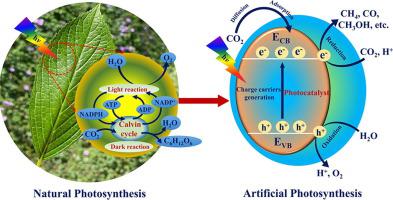Chemical Engineering Journal ( IF 13.3 ) Pub Date : 2021-10-20 , DOI: 10.1016/j.cej.2021.133031 Abhinandan Kumar 1 , Vasudha Hasija 1 , Anita Sudhaik 1 , Pankaj Raizada 1 , Quyet Van Le 2 , Pardeep Singh 1 , Thi-Huong Pham 3 , TaeYoung Kim 3 , Suresh Ghotekar 4 , Van-Huy Nguyen 5

|
To date, the elevating atmospheric carbon dioxide (CO2) levels are becoming a global concern, which has promoted scientists to seek possible solutions for reducing CO2 emissions or capturing them. Solar light-assisted catalytic conversion of CO2 into valuable chemicals has been considered viable to mitigate the environmental and energy crisis simultaneously. In this regard, an artificial photosynthesis system, often called “artificial leaf” consisting of substantial structural components and reaction parameters of natural photosynthesis to attain solar light-driven CO2 conversion, is up-and-coming. Inspired by natural leaves, photocatalytic and photoelectrocatalytic artificial leaf structures that mimic natural photosynthesis and efficiently utilize solar energy to convert CO2 into value-added products are of great significance. This review focuses on the basic concepts of photo/electrocatalytic artificial leaf systems, emphasizing advanced structural arrangements and the mechanistic insights for CO2 reduction. The recent advances in the structural design of artificial leaves involving Z-scheme biocatalytic photoelectrochemical devices, photocatalytic prototype, and latest 3D printing has been extensively explored and discussed. The crucial applications of artificial leaf devices for the selective conversion of CO2 into carbon monoxide (CO), methane (CH4), and formate have been outlined. Finally, we conclude and provide a vision with an in-depth discussion on how the present state-of-the-art advances and various challenges in this field. We expect to believe this comprehensive study could stimulate more remarkable research efforts to design efficient artificial leaf for light-driven CO2 reduction towards selective solar-to-chemical products in the coming years.
中文翻译:

用于光驱动二氧化碳减排的人造叶子:基本概念、先进结构和选择性太阳能化学产品
迄今为止,不断升高的大气二氧化碳 (CO 2 ) 水平正成为全球关注的问题,这促使科学家寻求可能的解决方案来减少或捕获CO 2排放。太阳能光辅助将 CO 2催化转化为有价值的化学品已被认为是同时缓解环境和能源危机的可行方法。在这方面,一种人工光合作用系统,通常称为“人工叶”,由自然光合作用的重要结构成分和反应参数组成,以获得太阳光驱动的 CO 2转换,是后起之秀。受天然树叶的启发,模拟自然光合作用并有效利用太阳能将CO 2转化为增值产品的光催化和光电催化人工树叶结构具有重要意义。本综述侧重于光/电催化人工叶片系统的基本概念,强调先进的结构排列和 CO 2还原的机理见解。涉及Z-scheme生物催化光电化学装置、光催化原型和最新3D打印的人造树叶结构设计的最新进展已被广泛探索和讨论。人工叶片装置在 CO 2选择性转化中的关键应用已概述成一氧化碳 (CO)、甲烷 (CH 4 ) 和甲酸盐。最后,我们总结并提供了一个愿景,并深入讨论了该领域目前最先进的进展和各种挑战。我们希望相信这项综合研究可以激发更显着的研究工作,以在未来几年内设计用于光驱动 CO 2还原的高效人造叶子,以生产选择性的太阳能化学产品。











































 京公网安备 11010802027423号
京公网安备 11010802027423号